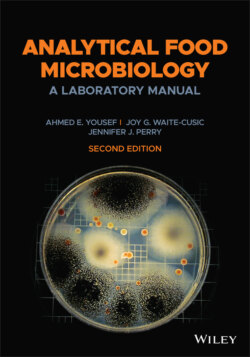Читать книгу Analytical Food Microbiology - Ahmed E. Yousef - Страница 67
Population Counting
ОглавлениеAfter the colony count is determined, the analysist should be able to determine the concentration of a microorganism (or a microbial group) in the food. The concentration is often expressed as CFU per gram of that food. As inidicated before, this concentration will be referred to as “population count,” and it is governed by the following general equation:
To calculate the denominator of equation 3.5, one should know the volume of diluted homogenate that has been plated and the concentration of food in that dilution.
The volume dispensed in a Petri plate is commonly 0.1 ml for spread‐plating and 1.0 ml for pour‐plating, but volumes other than these can be used. The concentration of food in this diluted homogenate can be considered to equal the dilution factor. For example, if a food has been homogenized and diluted 1:100 (i.e., 10–2 dilution factor), this results in a concentration of 0.01 g of food per g (or mL) of diluted homogenate. Therefore, equation 3.6 can be rewritten as follows:
As previously stated, the density of food, diluted homogenate and diluent is approximated as 1 g/ml. Note that volume of sample dispensed is quantified in ml. If analysts have dispensed a volume measured in μl, this value will need to be adjusted to yield a correct population count.
